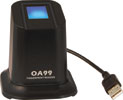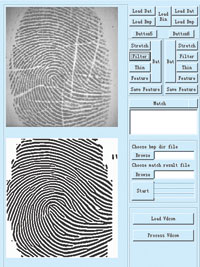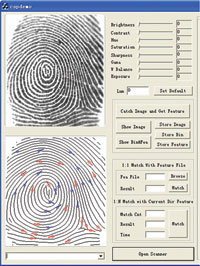

Vivian Taback discusses how to avoid problems in scanning a fingerprint.
To understand why so many false readings are made on biometric devices, one needs a basic understanding of the fingerprint identification process. At each stage, many variables can lead to a failed identification.
The basis of all fingerprint recognition is the conversion of a visible picture of the lines on the finger into a coded template that a computer can analyse and compare. Although this is a complex process, it can be understood in a simple way.
1. Using sophisticated optics and a digital camera, the sensor takes a photo of the finger. If the colour of the lighting is carefully chosen, a clear picture is obtained even from poor prints.

2. Images captured from the sensors are noisy, have poor contrast, contain flaws and often are smudged. In high-end readers, intensive analysis of the image characteristics with powerful image enhancement techniques yields high quality ridge images. Moreover, many erroneous features are efficiently removed by noisy area reduction techniques, sometimes called image healing.
3. Next the patterns such as ridge endings and splits are identified, which are called minutia points, and their position and direction are stored as number codes. The whole set of codes of these points is known as a template.

A fingerprint identification system has two basic stages:
1. Enrolment – when a coded template of the fingerprint is stored on the reader for all future comparisons.
2. Identification – when the person presents a finger and the reader compares the presented print with the templates in its database and decides if there is a match. If none match, there is a rejection – that painful ‘beep’.
Initial template
The most obvious source of failure is that the initial template is not good enough. This can be understood as follows. While the reader is in service, a person uses it many thousands of times and each time they place their finger differently, sometimes only pressing one side down and the next time perhaps another side. As well, there may now be a dirty spot on the finger covering some of the ridges or an injury which damages certain patterns in an area.
If that original template comes from an image of a small area or has patches of no recorded points, when in service, the reader is comparing partial information against the partial information in the initial template. The chance of matching is low. The person may need to keep pressing the finger until eventually the partial picture now captured exactly matches that poor initial template.
This is the most fundamental principle in making a fingerprint system work. Time and effort must be spent making the enrolment template as good as possible and it should include as big an area of the fingerprint as possible. The administrator must look at the image on the screen and ensure it is clear, centralised and large. Only then should the save button be pressed.
Winter woes
Most fingerprint readers seem to be less effective in winter. Why is this? The optics depend on the ridges of the fingerprint making a good image on the surface of the sensor. If the person’s skin is very dry, which occurs commonly in winter and also after washing ones hands, this image is patchy and cannot be identified. This is especially serious if it occurs at enrolment, as the initial template will be of poor quality.
A very easy fix is for the person to rub the finger on the palm of the hand or just touch the forehead. The skin usually picks up enough natural skin oils to get a good read.
Grannies and pianists
What grannies and pianists have in common is that their fingerprints may be feint or non-existent. Elderly people have skin which is soft and thin and their prints may not be visible. Certain types of work such as bricklaying and carpentry are known to result in worn fingerprints. Pianists, who play a lot, often have smooth fingertips.
To account for the possibility of a single person or a few on a large site rendering a whole system unusable due to them having no fingerprints, readers with built-in RFID identification should be used. Then if necessary, those few problematic people can be issued with an RFID card.
Latent prints
When a child puts a sticky hand on a window, the image of the hand has to be washed off. In a similar way every scan on a fingerprint reader leaves a feint image behind, called a latent print. This image should not be seen by the reader, as one does not want a person to be identified as the person who used the reader before him.
The light source should be designed to not reflect off these latent prints. A blue non-point source light is very effective in this. Some readers use a combination of colours to improve the picture quality and avoid the latent prints.
Innovations for a good read
Other methods and techniques have been invented or designed to maximise the effectiveness of fingerprint readers.
Automatic update: This is a method where the reader actually updates the stored template each time a new successful read occurs. What this does can be compared to the final stages of making a jigsaw puzzle. Imagine that the picture of the puzzle can already be recognised but there are gaps here and there. Each time another piece is added the picture becomes more complete.
Multispectral imaging: The fingerprint ridges that we see on the surface of the finger have their foundation beneath the surface of the skin. When surface fingerprint information is combined with subsurface fingerprint information and reassembled in an intelligent and integrated manner, the results are more consistent, more inclusive and more tamper resistant. Also, these subsurface layers are not obscured by moisture, dirt or wear. By using different colour lights with a polarising technique, these layers can be revealed.
Improved matching algorithms: The key to successful matching of a good image with a large database of good templates is the computer program that searches and matches. The speed and ability of available processors improves daily. By using the best and fastest processors, engineers are able to create programs that work fast, yet do intensive analysis. Manufacturers of fingerprint readers are therefore regularly upgrading their electronics to use the latest processors. This means that every new generation of reader should show a marked improvement in matching speed and accuracy.
Successful fingerprint matching seems an almost impossible target due to the many variables in the real world. Yet by combining the best technology with proper training of administrators and users, it can in fact be an almost trouble free part of one’s enterprise administration.
For more information contact Itatec, +27 (0)11 264 0530, [email protected], www.itatec.co.za
| Tel: | +27 11 264 0530 |
| Email: | [email protected] |
| www: | www.itatec.co.za |
| Articles: | More information and articles about Itatec |

© Technews Publishing (Pty) Ltd. | All Rights Reserved.